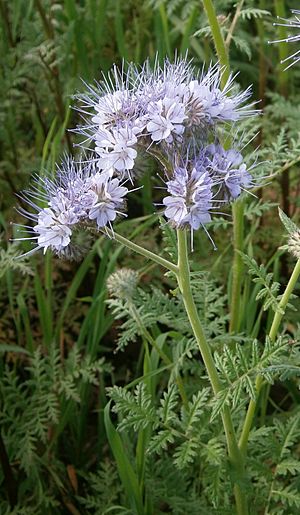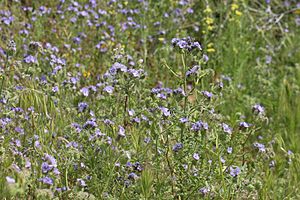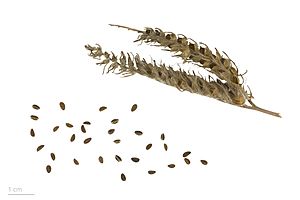Lacy phacelia facts for kids
Quick facts for kids Lacy phacelia |
|
|---|---|
 |
|
| Scientific classification | |
| Genus: |
Phacelia
|
| Species: |
tanacetifolia
|
Phacelia tanacetifolia is a type of flowering plant. It belongs to the borage family, called Boraginaceae. People often call this plant lacy phacelia, blue tansy, or purple tansy.
Contents
What's in a Name?
The name Phacelia comes from an old Greek word. It means 'bundle'. This is because the plant's flowers grow close together in a bunch. The second part of its name, tanacetifolia, means 'with leaves like a Tanacetum plant'.
Plant Description
Phacelia tanacetifolia is an annual plant. This means it grows, flowers, and dies within one year. It can grow quite tall, up to about 100 centimeters (39 inches). It might have a few branches or none at all.
The wild version of this plant feels a bit sticky. It is also covered in short, stiff hairs. Its leaves are usually divided into smaller parts. These smaller parts have deep, fancy cuts, making them look like lace. This is why one of its common names is 'lacy phacelia'.
The flowers grow in a dense, hairy cluster. This cluster is called an inflorescence. It often curves or coils like a snail shell. The flowers are bell-shaped and come in shades of blue and lavender. Each flower is less than a centimeter long. They have long, whisker-like parts called stamens sticking out.
The seeds of this plant are special. They need darkness to sprout. This is called being "negatively photoblastic" or photodormant.
Where It Grows and Why It's Useful
Natural Home
Phacelia tanacetifolia is originally from the Southwestern United States. It also grows in northwestern Mexico. You can find it most often in the deserts of southern California. It usually grows below 5,000 feet (about 1,500 meters). Sometimes, it can be found at much higher places too.
Helping Farmers and Bees
Outside its natural home, farmers use this plant for many reasons. It is planted as a cover crop. This means it covers the soil to protect it. It is also a great bee plant. Its flowers are full of nectar, which bees love. This plant helps attract other helpful insects too.
Farmers also use it as green manure. This means they grow it and then mix it into the soil. This makes the soil healthier. It is also grown as an ornamental plant because its flowers are pretty.
You might see it planted in vineyards or next to farm fields. Farmers like it because its long, coiling flower clusters bloom for a long time. This is because the flowers open one after another. It is a good insectary plant. It brings in pollinators like honey bees.
Fighting Pests Naturally
This plant also attracts hoverflies. Hoverflies are very helpful. They eat aphids and other tiny pests that can harm crops. This makes Phacelia tanacetifolia useful for natural pest control.
See also
 In Spanish: Phacelia tanacetifolia para niños
In Spanish: Phacelia tanacetifolia para niños




